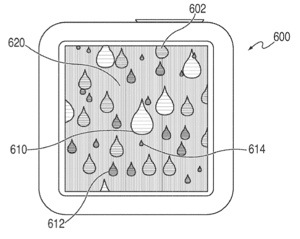Apple wants to make screen savers more interesting. At least on iOS devices, as well as, perhaps, Macs. A company patent (number 20110109538) for environment sensitive display tags has appeared at the US Patent & Trademark Office.
This is directed to dynamic tags or screen savers for display on an electronic device. The tags can include several dynamic elements that move across the display. The particular characteristics of the elements can be controlled in part by the output of one or more sensors detecting the environment of the device.
For example, the color scheme used for a tag can be selected based on the colors of an image captured by a camera, and the orientation of the movement can be selected from the output of a motion sensing component. The tag can adjust automatically based on the sensor outputs to provide an aesthetically pleasing display that a user can use as an fashion accessory. The inventors are Duncan Kerr, Nicholas King and Michael B. Victor.
Here’s Apple’s background and summary of the invention: “An electronic device can include a display for providing information to a user. When the display is not in use, the electronic device can typically turn off the display circuitry to limit the power consumption of the device. The resulting display window may not have much aesthetic appeal, and may not display any information of use to the user.
“In some cases, however, the electronic device can include a screen saver to display when the display is not in use. For example, the electronic device can display a screen saver after a timeout has lapsed without receiving any user interaction with the device. As another example, the electronic device can display a screen saver in response to a user locking or logging out of the device. The screen saver can include any suitable information or content to be displayed. For example, the screen saver can include a static image.
“As another example, the screen saver can include dynamic elements that move on the display in a preordained manner. For example, a screen saver element can include a geometric form that moves across the display and bounces from the sides of the display. As another example, a screen saver element can include an animated animal traversing a background (e.g., a fish swimming across an underwater image). These screen savers, however, do not vary — the elements always move in the same manner, and the color scheme used for the screen saver evolves in a predictable and preordained sequence.
“This is directed to systems, methods and computer-readable media for displaying dynamic tags or screen savers that change based on detected characteristics of the user’s environment. In particular, this is directed to dynamic tags that can serve as a fashion accessory by changing based on characteristics of the user’s environment.
“In some embodiments, an electronic device can include a display on which different types of information can be displayed. When the display or the device is not in use (e.g., after a particular period of inactivity), the electronic device can enable a screen saver or tag mode. In this mode, the electronic device can display a screen saver or tag that may include dynamic elements. In particular, to enhance the appeal of the tag, one or more tag elements, or one or more characteristics of the tag display can vary based on the output of sensors detecting attributes of the device environment.
“The electronic device can include any suitable type of sensor. For example, the electronic device can include motion sensing components. As another example, the electronic device can include a microphone. As still another example, the electronic device can include a camera. One or more characteristics of the tag can be tied or correlated with the output of the sensors.
“For example, the direction or speed of motion of an element in the tag can be related to the motion of the electronic device as detected by the motion sensing components. As another example, the color palette or color scheme selected for a particular tag can be selected based on the colors of the environment detected by a camera. To enhance the aesthetic appeal of the electronic device as a fashion accessory, the color palette selected for the tag can be selected to match or complement the colors worn by the user or present in the user’s environment.
“To ensure that the displayed tag remains of interest to the user, the electronic device can dynamically change the appearance of the tag based on the evolution of the sensor outputs. For example, if the electronic device determines from the camera that the color schemes of the user’s room have changed, the displayed tag can adjust to reflect the new detected colors. As another example, the electronic device can monitor the orientation of the device relative to the earth using a motion sensing component to ensure that a tag element moves in a manner oriented relative to the earth, and not relative to the display orientation.”
— Dennis Sellers


